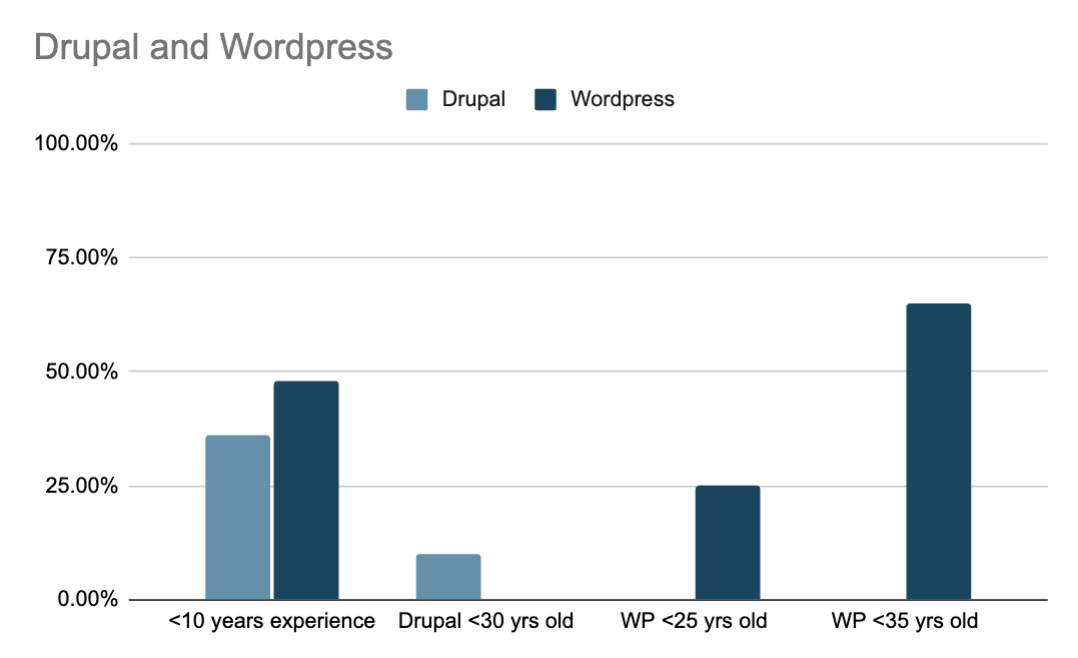
With Drupal Starshot on the horizon, the possibilities of expanding the market share for Drupal through Drupal CMS and building further on the power of Drupal Core creates a new vision, new opportunities and hopefully a renewed path of growth for our beloved community. So, while we all look to fully understand the Starshot initiative and its implications for our businesses and the way we market Drupal, it seems like a good time to also reflect, and perhaps begin to really address, the dwindling Drupal talent pool as well as lack of available Drupal jobs. We need to take a hard look at how we can attract those who will help to multiply and diversify our legions across the globe to support the project into the future.
The lack of Drupal talent and non-existent formal workforce pipeline for now and the future is a topic that, even having been constantly, at least casually discussed for years, has had no real community-wide solutions implemented to overcome it. Perhaps this is largely because resources (bandwidth & funds) tend to flow to areas that have immediate priority, have clear goals and can show immediate results. Experienced talent deficits are not easily, clearly, nor quickly fixed.
Additional challenges are that Drupal, at least what will be known as Drupal Core, has a relatively lengthy learning curve, and most companies tend to exclusively hire experienced developers. Since time is a required component of creating experience there is no speedy way to improve the flow rate of the Drupal talent that comes into the community. It doesn’t help that those new to Drupal struggle to find sustainable work and compensation to propel their journey through the novice years.
We must look at the supply of talent in the same way we look at our potential markets.
Consider that as people who are just starting out, changing or shifting their careers look to options, those with the foundations to take on web developer careers have a pretty good outlook. The US Department of Labor, Bureau of Labor Statistics (BLS) anticipates that, in the US alone, web developer careers will grow 8% (faster than average for most careers) from 2023 to 2033; with an estimated 16,500 new jobs every year. BLS explains, “Many of those openings are expected to result from the need to replace workers who transfer to different occupations or exit the labor force, such as to retire.”
Good news for attracting job seekers who would like to be web developers, but it also demonstrates that there is competition among the various web development platforms to attract them. This is not so great news for Drupal, with a conspicuously aging talent pool; an awareness problem among the general, (even tech-savvy) career-seeking populations and really no overall effort in place to mitigate either issue. It would be comforting to think that the workforce issue is with web development in general; but data reflects otherwise. This is a Drupal problem.
According to The 2024 Drupal Developer Survey, (Of which ~700 people responded) 36% of respondents have less than 10 years of experience. Compare that to the Wordpress Developer survey (which touts 90,000 respondents) that indicates about 48% have less than 10 years in. And, although age is not a true representation of experience, it can’t be ignored especially when thinking long-term and realizing that (audible gasp) less than 10% of Drupal respondents are under the age of 30.
The Wordpress survey tiered the age question differently, but ~25 % of the Wordpress respondents are under 25 (more than double the Drupal <30 respondents and 5 years less (& lower) in the tier!) while (second audible gasp) 65% are under 35 years old.

It is clear that a concerted, well-supported movement to help create a scalable workforce pipeline to nourish the future of Drupal CMS & Drupal Core would be a smart action item to run in tandem with the development and introduction of the Starshot initiative. It’s true that there has not historically been ongoing, consistent, widespread efforts to do this; but new tracks for growth and added market share need to be supported, so we at least have to solve our current lack of a workforce pipeline to keep the project moving.
Of course, it’s not usually easy to get broad participation for efforts with mostly long-term results, even with widespread sentiment recognizing the need. But honestly, we have to at least do better for the new talent we have.
Consider a snapshot of the last 9 months (1 day of jobs statistics/month) of Drupal jobs posted on jobs.Drupal.org.
Since January, the highest number of entry level positions open per month is two, and this is with two months of none being posted at all. This is a problem, perhaps The problem because the beginners are already struggling the most just learning Drupal.
Those who are not employed and seeking to learn, need to support themselves while they do so; and without any jobs to provide experience, they may never gain the experience needed to even be considered for the majority of positions that are open.
Without the opportunity or support to gain experience, people often seek other careers. Perhaps the shorter learning curve promised by Starshot through Drupal CMS will help, but we still need to address the lack of new and young talent coming into, and staying with the community.
With some time and resources from at least a few like-minded organizations, and eventually a meaningful shift in hiring practices from forward-thinking organizations; there is a way forward. Consider the IXP-Fellowship, a community initiative for onboarding inexperienced developers that hopes to create incentives for companies to guide new developers through the very beginning of their career in Drupal. There are also strategies that, taking into account individual organizations’ time and funding constraints, can leverage outside resource streams that can be combined with these types of community efforts. The key is recognizing the issue, and working on efforts that can help to build a Drupal workforce pipeline. These are a great start because, somehow, companies need to start showing some love to beginners in hiring.
Successful efforts would include outreach, training, and most importantly, placement opportunities in entry-level positions that will support, and in turn retain, novice developers through the various stages (years) of gaining experience and skill. This last bit may be the hardest to make happen, but it is key to success.
We’ve begun an effort to start collecting Drupal jobs data so that we can track, on a quarterly basis, the status of entry level and more advanced positions that are open. We’ll start sharing our Drupal Jobs report at the end of every quarter in an effort to keep the issue top of mind.
If you’ve been inspired or at least have become a bit interested in how you might contribute to sustaining and building Drupal talent for the future, check out:
Drupal Association IXP Fellowship program
Internship/Apprenticeship Host page
Discover Drupal information page
Feel free to also send me your ideas and thoughts: [email protected]

Comments
Have you noticed how many…
Have you noticed how many Drupal job applications look for candidates who are “Triple Certified?” Meaning they’ve passed the Acquia Developer exam, the front-end developer exam, and the back-end developer exam. This a symptom of an underlying condition that we should address.
First: it’s really double certified, not triple. Anybody who can pass both the front-end and the back-end exam can easily pass the dev exam. It’s redundant and requires another $300 cost — and the loss of days of work to prep for and take it.
But the bigger problem is that a healthy project shouldn’t NEED to add people who are BOTH front-end and back-end people. A little of that can be chalked up to sloppy project management (job descriptions often include a crazy quilt of “required” skills) but a good chunk is structural to Drupal itself. To little care has been taken to isolate the PHP programming requirements into the parts that need it. Drupal’s framework aspect bleeds into all the other parts. What could be a “low code”‘l environment instead presents as a framework more complicated than Laravel, which requires the programmers to support a demo environment that often doesn’t function the way it shouid.
Add new comment